#kuwait news today
Text
Kuwait urges public to report LGBT symbols
Kuwait urges public to report LGBT symbols
Kuwait urges public to report LGBT symbols
Kuwait has urged members of the public to report any displays or promotion of the ‘pride flag’ or other symbols of the LGBT community, the latest step in the country against the perceived promotion of homosexuality.
Read- Kuwait: No Covid related death in the country since April 3rd
“Inform us about the flag or any signs or phrases inviting or…

View On WordPress
#kuwait#Kuwait City#kuwait latest news#Kuwait News#kuwait news latest#kuwait news today#kuwait today#Kuwait urges public to report LGBT symbols#kwttoday#latest kuwait news
0 notes
Text

Oh no!
Anyway!
Yeah apparently Hezbollah are describing the film as a threat to society.
Unironically.
That’s hysterically stupid!
#personal stuff#dougie rambles#barbie movie#barbie#Oppenheimer#tangentially#everything is in the news today#hysteria#moral panic#saudi arabia#kuwait#lebanon#middle east#fuck Hezbollah#wtf#banned#censorship#banning#madness#hezbollah#what#this shit is bananas
10 notes
·
View notes
Text
there have been multiple flour massacres since 29 Feb including two today!!
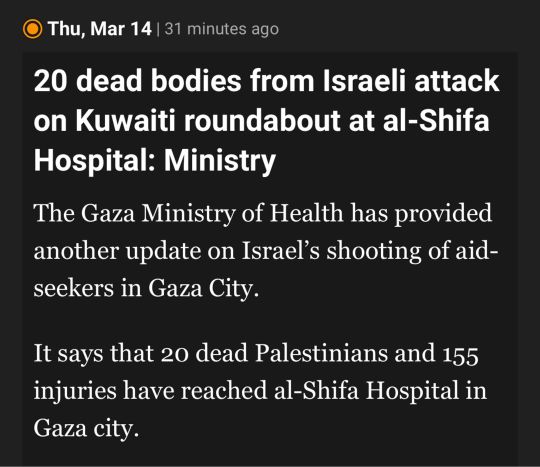
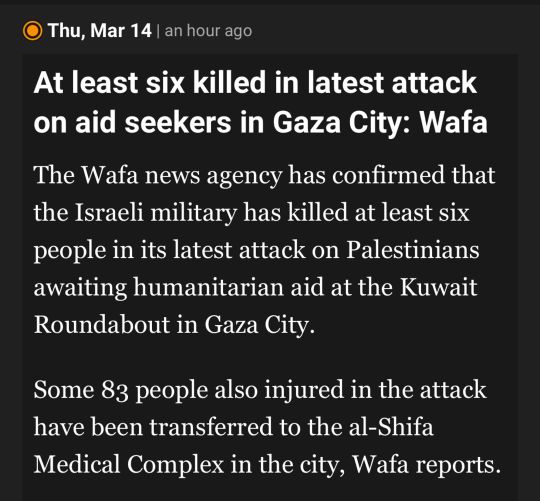


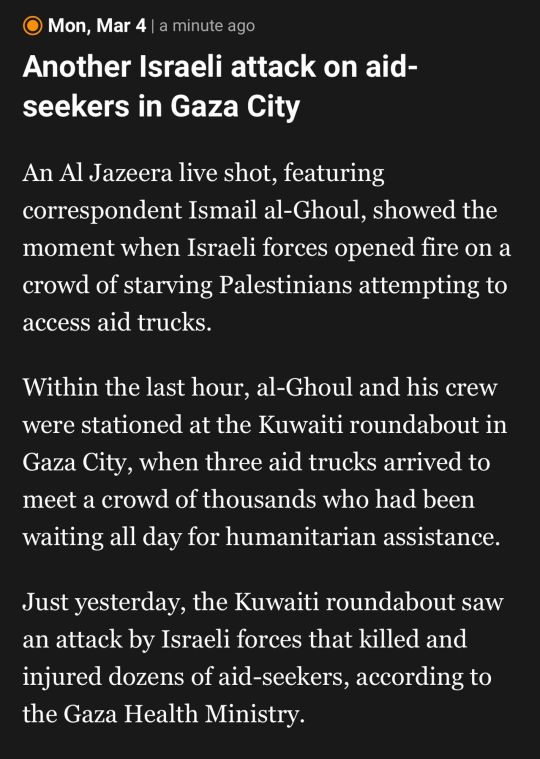
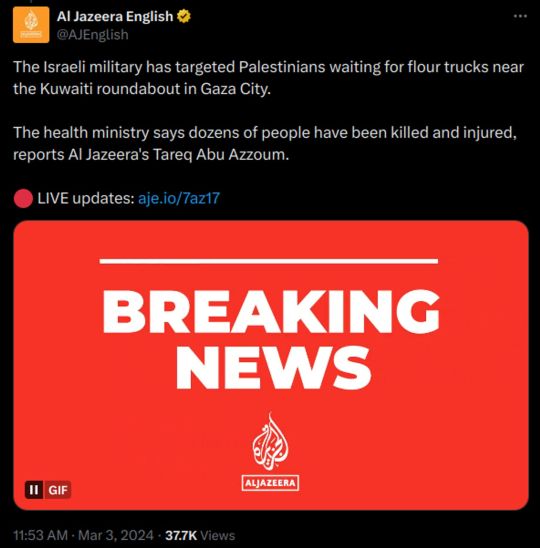
there were flour massacres before 29 Feb
From mid-January to the end of February 2024, the Office has recorded at least 14 incidents involving shooting and shelling of people gathered to receive desperately needed supplies at Al Kuwait Roundabout on Salah Ad Deen Road and Al Nabulsi Roundabout - two entrances to Gaza City - with a majority of these incidents resulting in casualties.
so-called Israel has an established pattern of targeting starving, desperate civilians — including children — as they seek food and other necessities
5K notes
·
View notes
Text

Check out my YouTube channel for great shooting videos, enjoy 😉
#youtube#video#shooting#perazzi#shotgun#perazzikuwait#shotguns#سلاح#شوزن#اسلحه#فشق#Alishooting#new#fun#today#Kuwait
0 notes
Text
OP: wizard_bisan1 posted: March 23 2024. link
visual description: Bisan, an arab girl with black curly hair, standing in the street wearing a hoodie. In the background there are four story tall buildings that are white. A couple people are walking in the background and some cars and horses are moving past. One of the cars is an ambulance with the flag of Palestine and the flag of Kuwait. Two red signs with white writing can be seen but the text is blurry.
During the video 3 different pictures are put up on screen. First a photograph of Muhammad al-Nunu. Later two from a news article about the israeli soldiers attacking, one showing the soldiers and one showing a brown tanks, there is text in Arabic. Another of three boys carrying a dead person.
transcript:
Hey everyone, this is Bisan from Gaza. It's the day 69 after hundred of the genocide and the day 13 of the holy month of Ramadan.
And it's the day six of the besieging and invading of Al Shifa hospital, attacking the hospital, the displaced people inside, the doctors and the injuries by the israeli army and the israeli soldiers, the israeli tanks and bulldozers.
So for those who don't know, people are either inside one building of Shifa complex buildings, without water, without food, without the ability to move anywhere or to get outside that building and to be executed.
And talking about execution today, Muhammad al-Nunu, he is a doctor. The israeli army executed Muhammad al-Nunu because he refused to leave the unit that he is working in and refused to leave his patients and preferred to stay to complete their treatment because a lot of the ICU, of the intensive care unit patients died, passed away because there is no electricity, there is no food, there is no staff, there is bombing and burning for the hospital utilities.
So he refused to leave them and he was executed. He was killed in front of the people, in front of the patients. This is what is happening now in Al Shifa hospital.
It is a hospital and this is happening to them.
Thousands of people, women, children and innocent men and civilians are stuck in a building, in Al Shifa hospital without food, without water.
They started to drink the hospital storage saline solutions. It's the only liquids that they have.
And no one is talking about that. No one, no media, not enough media, no government, no one is talking about this.
And this is not the only horrific thing that happened today in the north of Gaza Strip, by the way, today between ten to 20 people were killed by the israeli shooting on the liquid roundabout while they were waiting for their humanitarian aid.
They were waiting for food because they're starving to death. In the north of Gaza Strip, in Ramadan months, they were waiting for food and they were killed by the israeli army.
How many times we need to scream more about that?
The north of Gaza Strip is under attack like it was the first days of this genocide. Exactly.
They are brutally killed and bombed. It is a hospital with thousands of innocent people, medical staff, injuries, civilians, and they are starved - to death. They are without water, without treatment
They are bleeding in front of each other until the death. And everyone is out of the building executed by snipers or inside starving to death.
This is what is happening now inside Al Shifa Hospital now, at this moment, for six days.
transcript end
caption:
North updates, very important.. watch to the end.
#free palestine#palestine#news#shifa hospital#al Shifa hospital#wizard bisan#gaza#north gaza#transcribed video#video#wizard_bisan1#wizard bisan1#journalism#TikTok#leve palestina#let gaza live
582 notes
·
View notes
Text
Magnitude 5 earthquake strikes off Kuwait
New Post has been published on https://www.timesofocean.com/magnitude-5-earthquake-shakes-kuwait/
Magnitude 5 earthquake strikes off Kuwait
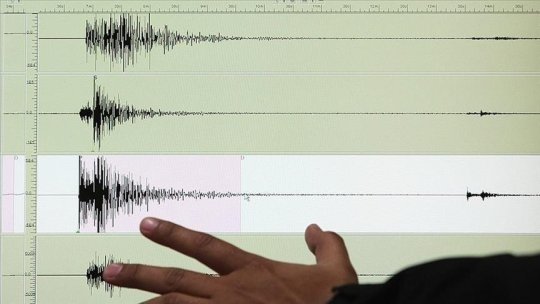
Kuwait (The Times Groupe)- Kuwait has announced an earthquake of magnitude 5 shook south of the Persian Gulf country on Saturday.
Kuwait’s National Seismic Network reported the quake occurred at 4:28 local time (1:28 GMT) at a depth of five kilometers southwest of Al-Ahmadi province, the state news agency KUNA reported.
There were no injuries or damage reported.
#Al-Ahmadi province in Kuwait#All news about Earthquake#earthquake in Kuwait#earthquake in Middle east#Earthquake reported in Kuwait#earthquake strikes off#Geological Survey#Global Seismic Reports#Kuwait#Kuwait's National Seismic Network#Latest Earthquake today news#Latest Earthquakes#latest News#news agency KUNA#Persian Gulf#The Times Groupe#Times#Times Of Ocean#Today Latest News about earthquake#What are Earthquake Fault Lines?#World
0 notes
Text
27/05/24
Today's breaking news:
An IOF drone strike directly targeted the emergency entrance of Martyr Salah Ghandour Hospital in the city of Bint Jbeil with a missile in southern Lebanon.
Settlers have set fire to lands in Ain Qadis in the town of Husan, west of Bethlehem, this morning.
Palestinian Ministry for Health: The "isr@eli" occupation committed 7 massacres against families in the Gaza Strip, resulting in 66 martyrs and 383 injuries arriving at hospitals in the past 24 hours.
At least 3 Egyptian soldiers were reportedly killed in a gunfire exchange at the Rafah border crossing that took place between the Isr@eli army and Egyptian soldiers.
Two medical staff working at Kuwait Specialized Hospital were martyred as a result of being targeted by “isr@eli” reconnaissance aircraft while they were on duty in front of the hospital gate in the center of Rafah.
An Isr@eli air strike targeted a group of civilians at the entrance of the Kuwaiti hospital in Rafah.
The Isr@eli occupation army detonates a residential complex in the Sabra neighborhood in the center of the Gaza Strip.
Zionist forces assaulted and arrested 8 Palestinians in Haifa in northern occupied Palestine in a protest calling for the end of the war on Gaza.
An Isr@eli drone footage optioned by Al Jazeera shows Israeli forces blowing up residential blocks in Al Zaytoun neighborhood in Gaza city.
A number of Palestinians were injured by an Isr@eli air strike in Rafah.
#free palestine#pro palestine#gaza#news from the world#boycott starbucks#boycott israel#from the river to the sea palestine will be free#palestine#boycott disney#boycott mcdonalds#freelebanon#free lebanon#eyes on rafah#rafah#all eyes on rafah#free rafah#rafah under attack#free gaza#gaza genocide#save rafah#gaza strip
33 notes
·
View notes
Text
[ 📹 The moment an "Israeli" airstrike targeted a civilian residence near the Kuwait Hospital in the city of Rafah, in the south of Gaza, resulting in a fire that engulfed the residential building.]
🇮🇱⚔️🇵🇸 🚀🏘️💥🚑 🚨
ZIONIST AIRSTRIKES TARGET CIVILIAN HOMES IN RAFAH ON DAY 173 OF "ISRAEL'S" ONGOING WAR OF GENOCIDE
On the 173rd day of "Israel's" ongoing war of genocide in the Gaza Strip, the Israeli occupation forces (IOF) committed a total of 8 new massacres of Palestinian families, resulting in the deaths of no less than 76 Palestinians, mostly women and children, and wounding another 102 others over the previous 24-hours.
According to Gaza's Ministry of Health, “Many victims are still trapped under rubble and on the roads and rescuers can’t reach them."
The Zionist occupation army also purposely blocks ambulance and civil defense crews from reaching targeted sites, preventing victims from reaching hospital care in time to treat their injuries.
Meanwhile, occupation airstrikes accelerated across the entirety of the Gaza Strip, from Beit Hanoun in the north to Rafah in the South, with violent shelling everywhere in between.
Zionist air forces bombed a civilian residence belonging to the Dhair family in the city of Rafah, in the southern Gaza Strip, resulting in the deaths of at least 11 civilians, with a number of others wounded in the strike.
Simultaneously, IOF warplanes targeted several residential homes without major casualties, bombing the homes of the Al-Hamaida family in Al-Shaboura, three civilian residences in the Yabna Camp in central Rafah, and yet another civilian home in the vicinity of the border with Egypt.
Occupation fighter jets also launched several firebelts on various areas of Khan Yunis, in south-central Gaza, with local civil defense crews recovering the bodies of 12 Palestinians killed in Zionist strikes.
The Israeli occupation army also announced the assassination of Morwan Issa, Deputy Commander-in-Chief of the Al-Qassam Brigades, belonging to the Hamas resistance movement, along with several deputies, after an IOF raid on the Nuseirat Refugee Camp two weeks ago. Al-Qassam has yet to confirm the death of the Issa, considered one of the most prominent leaders of the resistance group.
In another occupation airstrike, IOF warplanes bombarded a residential home belonging to the Al-Hamayda family, in the city of Rafah, resulting in several casualties.
In yet another atrocity against the starving families of Gaza, Zionist Merkava tanks opened machine gun fire on a group of hungry Palestinians waiting for humanitarian aid near the Al-Kuwaiti roundabout, at the intersection of Street 10 and Salah al-Din Street in Gaza City, critically injuring at least two civilians.
Similarly, at least one civilian was murdered and a number of others wounded after Zionist occupation warplanes bombed a group of starving civilians waiting for humanitarian aid, east of Beit Hanoun, in the northern Gaza Strip.
The Zionist occupation army also stormed today the Nasser Medical Complex in Khan Yunis, in south-central Gaza, kidnapping medical staff and arrested displaced civilians sheltering in the hospital. Occupation soldiers also forced the evacuation of some civilians sheltering in the medical complex.
Meanwhile, Zionist forces dropped bombs on a gathering of Palestinian civilians in the vicinity of Al-Mintar commercial crossing, also known as the "Karni" crossing, east of Gaza City, in the north of the Gaza Strip, martyring several civilians and wounding a number of others.
IOF fighter jets also bombarded a residential home in the Al-Daraj neighborhood of the Old City of Gaza, slaughtering two civilians and wounding several others.
A number of casualties were also reported as a result of an occupation airstrike targeting a civilian home near Al-Sousi Mosque, located in the Al-Shati Refugee Camp, northwest of Gaza City.
Elsewhere, Zionist artillery forces continue shelling al-Amal City, west of the Nuseirat Refugee Camp, in the central Gaza Strip, martyring one Palestinian and wounding others.
Occupation aircraft similarly bombed residential structures in the Al-Maghazi Camp, in the central Gaza Strip, killing two Palestinians.
The IOF also committed yet another horrific atrocity and slaughter of Palestinian civilians after bombing a residential building belonging to the Abu Hasira family, behind Al-Shifa Hospital, in the Al-Rimal neighborhood of Gaza City, martyring the entire family, with at least 30 killed in the massacre.
Occupation fighter jets also bombarded a residential building in the Jabalia Refugee Camp, in the north of Gaza, killing one Palestinian and wounding several others.
As a result of "Israel's" ongoing war of genocide in the Gaza Strip, the endlessly rising death toll has now exceeded 32'490 Palestinians martyred, over 25'000 of which being women and children according to the United States Pentagon, while another 74'889 civilians have been wounded since the start of the current round of Zionist aggression beginning on October 7th, 2023.
#source1
#source2
#source3
#source4
#source5
#source6
#videosource
@WorkerSolidarityNews
#gaza#gaza strip#gaza news#gaza war#gaza genocide#genocide in gaza#genocide#genocide of palestinians#israeli genocide#israel#israeli occupation forces#israeli occupation#israeli war crimes#war crimes#crimes against humanity#palestine#palestine news#palestinians#war#israel palestine conflict#politics#news#geopolitics#world news#global news#international news#breaking news#current events#free palestine#free gaza
23 notes
·
View notes
Note
holy shit new music !! may i ask which man the new song is about 👁
Out With A Bang is a work of fiction and any similarity to actual persons, living or dead, is purely coincidental. On a completely unrelated note, here is a list of interesting actual persons who are alive today and have real names and addresses:
Patrick Pouyanné, Chairman and CEO, TotalEnergies
Helge Lund, Chairman, BP
Bernard Looney, CEO, BP
Amin H. Nasser, CEO, Saudi Aramco
Yasir Al-Rumayyan, Chairman, Saudi Aramco
Zhang Yuzhuou, Chairman, China Petrochemical
Mike Wirth, CEO, Chevron
Viktor Zubkov, Chairman, Gazprom
Alexey Miller, CEO, Gazprom
Javad Owji, Chairman, National Iranian Oil Company
Ken Mackenzie, Chairperson, BHP Billiton
Mike Henry, CEO, BHP Billiton
PM Prasad, Chairman, Coal India
Octavio Romero Oropeza, CEO, Pemex
Jim Grech, CEO, Peabody Energy
Ryan Lance, CEO, ConocoPhillips
Sultan Al Jaber, CEO, ADNOC
Jean Paul Prates, CEO, Petrobras
Nawaf Saud Nasser Al-Sabah, CEO, Kuwait Petroleum Corp.
Toufik Hakkar, CEO, Sonatrach
John P Surma, CEO, Marathon Petroleum
Joseph Gorder, CEO, Valero
Greg Garland, CEO, Phillips 66
Basuki Tjahaja Purnama, President, Pertamina
15 notes
·
View notes
Note

April 14th update
Nothing new in the USA, but three new countries worldwide
On the statistics by number (which I send you on Google), America is third place again with 42% countries visited
Thanks for the stats!
Countries we're missing as of today (from what I can see) under the cut:
Americas
Belize
El Salvador
French Guiana
Guyana
Haiti
Honduras
Nicaragua
Paraguay
Suriname
Uruguay
Venezuela
Africa
Benin
Burkina Faso
Burundi
Cameroon
Central African Republic
Côte d'Ivoire
Djibouti
DRC (Democratic Republic of the Congo)
Equatorial Guinea
Eritrea
Gabon
Ghana
Guinea-Bissau
Lesotho
Liberia
Libya
Malawi
Mauritania
Mozambique
Niger
Nigeria
Republic of the Congo
Rwanda
Somalia
South Sudan*
Sudan*
The Gambia
Togo
Western Sahara
Zambia
Zimbabwe
*These appear to be one country on the stats map?
Eurasia
Afghanistan
Azerbaijan
Bangladesh
Belarus
Bosnia and Herzegovina
Brunei
Iraq
Iran
Israel
Kuwait
Kyrgyzstan
Laos
Nepal
North Macedonia
Oman
Qatar
Syria
Tajikistan
Turkmenistan
Oceania
Papua New Guinea
Various islands that are too small to tell
12 notes
·
View notes
Text
Kuwait: Banks restart loans for expatriates
Kuwait: Banks restart loans for expatriates
Kuwait: Banks restart loans for expatriates
After a break of almost three years due to the Covid pandemic, some of the banks in Kuwait restarted issuing loans to expatriates. Some of the banks have updated their policy as they decided to expand their loan portfolio to expatriates working in the private sector with new terms and conditions, local Arabic daily Al-Rai reported quoting banking…

View On WordPress
#Kuwait City#kuwait latest news#Kuwait News#kuwait news latest#kuwait news today#kuwait today#Kuwait: Banks restart loans for expatriates#kwttoday#latest kuwait news
0 notes
Text

ok replying again
hi! i saw the three temporary exhibitions (picasso, barbey & arkadia) today at mnw. the barbey photography one was the most interesting to me and there were some real gems there - the two kuwait photos in the witnessing history section were amazing (one of a man carrying a tv on his back, the other of strongmen shows ads), i also really liked the photos portraying the poverty in south italian towns, streets of morocco, and 80s poland. i wish it was more descriptive, i guess? i get that most photograohy exhibitions want the photos to speak for themselves but here i feel like it could use more text giving context for barbey's travels and work, what his methods of getting close to the societies he was portraying were (the very beginning of the exhibition was hinting at this angle, i think? they mentioned him staying for a long time in brazil to get to know the issues there, and suggested it was his way of doing responsible photojournalism or sth, but it wasn't much explored or well fleshed out later)
as for picasso - i am not a fan of his work. the ceramics were interesting and i liked the circus themed drawings a lot, but overall it was not really for me. the female centaur piece was funny tho
(then i passed by the museum shop and was shocked to find they no longer sell magnets?????? wtf?????)
and as for arkadia, i really really liked it, but i feel like most of the exhibits there are usually shown as permanent exhibition in mnw? so there wasnt much to Discover, just to watch again in a new company and context. it was also A Lot of time and themes to fit into one exhibition, so some parts left me wishing for more (queer arkadia!!!! show me more!!!!!). but overall it was all very pretty, some parts of it useful for the purposes of my masters thesis, and i agree with you than the more modern part of it was the most fun
tldr yall should go to the national museum in warsaw to see the temporary exhibitions (and then you can come back here and yell at me for finding picasso boring)
10 notes
·
View notes
Text
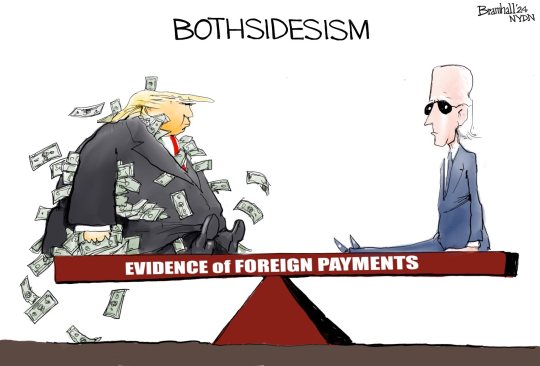
LETTERS FROM AN AMERICAN
January 4, 2024
HEATHER COX RICHARDSON
JAN 5, 2024
The Democrats on the House Oversight Committee today released a 156-page report showing that when he was in the presidency, Trump received at least $7.8 million from 20 different governments, including those of China, Saudi Arabia, United Arab Emirates, Qatar, Kuwait, and Malaysia, through businesses he owned.
The Democrats brought receipts.
According to the report—and the documents from Trump’s former accounting firm Mazars that are attached to it—the People’s Republic of China and companies substantially controlled by the PRC government paid at least $5,572,548 to Trump-owned properties while Trump was in office; Saudi Arabia paid at least $615,422; Qatar paid at least $465,744; Kuwait paid at least $300,000; India paid at least $282,764; Malaysia paid at least $248,962; Afghanistan paid at least $154,750; the Philippines paid at least $74,810; the United Arab Emirates paid at least $65,225. The list went on and on.
The committee Democrats explained that these payments were likely only a fraction of the actual money exchanged, since they cover only four of more than 500 entities Trump owned at the time. When the Republicans took control of the House of Representatives in January 2023, Oversight Committee chair James Comer (R-KY) stopped the investigation before Mazars had produced the documents the committee had asked for when Democrats were in charge of it. Those records included documents relating to Russia, South Korea, South Africa, and Brazil.
Trump fought hard against the production of these documents, dragging out the court fight until September 2022. The committee worked on them for just four months before voters put Republicans in charge of the House and the investigation stopped.
These are the first hard numbers that show how foreign governments funneled money to the president while policies involving their countries were in front of him. The report notes, for example, that Trump refused to impose sanctions on Chinese banks that were helping the North Korean government; one of those banks was paying him close to $2 million in rent annually for commercial office space in Trump Tower.
The first article of the U.S. Constitution reads: “[N]o Person holding any Office of Profit or Trust under [the United States], shall, without the Consent of the Congress, accept of any present, Emolument [that is, salary, fee, or profit], Office, or Title, of any kind whatever, from any King, Prince, or foreign State.”
The report also contrasted powerfully with the attempt of Republicans on the Oversight Committee, led by Comer, to argue that Democratic Joe Biden has corruptly profited from the presidency.
In the Washington Post on December 26, 2023, Philip Bump noted that just after voters elected a Republican majority, Comer told the Washington Post that as soon as he was in charge of the Oversight Committee, he would use his power to “determine if this president and this White House are compromised because of the millions of dollars that his family has received from our adversaries in China, Russia and Ukraine.”
For the past year, while he and the committee have made a number of highly misleading statements to make it sound as if there are Biden family businesses involving the president (there are not) and the president was involved in them (he was not), their claims were never backed by any evidence. Bump noted in a piece on December 14, 2023, for example, that Comer told Fox News Channel personality Maria Bartiromo that “the Bidens” have “taken in” more than $24 million. In fact, Bump explained, Biden’s son Hunter and his business partners did receive such payments, but most of the money went to the business partners. About $7.5 million of it went to Hunter Biden. There is no evidence that any of it went to Joe Biden.
All of the committee’s claims have similar reality checks. Jonathan Yerushalmy of The Guardian wrote that after nearly 40,000 pages of bank records and dozens of hours of testimony, “no evidence has emerged that Biden acted corruptly or accepted bribes in his current or previous role.”
Still, the constant hyping of their claims on right-wing media led then–House speaker Kevin McCarthy (R-CA) to authorize an impeachment inquiry in mid-September, and in mid-December, Republicans in the House formalized the inquiry.
There is more behind the attack on Biden than simply trying to even the score between him and Trump—who remains angry at his impeachments and has demanded Republicans retaliate—or to smear Biden through an “investigation,” which has been a standard technique of the Republicans since the mid-1990s.
Claiming that Biden is as corrupt as Trump undermines faith in our democracy. After all, if everyone is a crook, why does it matter which one is in office? And what makes American democracy any different from the authoritarian systems of Russia or Hungary or Venezuela, where leaders grab what they can for themselves and their followers?
Democracies are different from authoritarian governments because they have laws to prevent the corruption in which it appears Trump engaged. The fact that Republicans refuse to hold their own party members accountable to those laws while smearing their opponents says far more about them than it does about the nature of democracy.
It does, though, highlight that our democracy is in danger.
LETTERS FROM AN AMERICAN
HEATHER COX RICHARDSON
17 notes
·
View notes
Text
What was seen as an outlandish idea two years ago—that frozen Russian assets could be used to pay for war-torn Ukraine’s reconstruction—is edging closer to becoming reality, in what could become a landmark precedent in international law.
Financial institutions in the United States and Europe hold about $300 billion worth of Russian state assets that were frozen at the start of the war and which, if seized, could go a long way toward paying for the damage wrought by the invasion. The World Bank last year estimated the cost of that damage to be over $400 billion, and it has only grown since.
In the early days of the war, U.S. Treasury Secretary Janet Yellen dismissed the idea of seizing Russian assets as not “legally permissible.” But the notion has seen momentum recently, in part due to Russia’s continued assault on Ukraine’s civilian infrastructure and in part due to growing concerns over the near-term future of U.S. and Western aid for Kyiv.
Last week, the U.S. Senate advanced legislation that would authorize the seizure of frozen Russian state funds, following a similar measure earlier in the House of Representatives. The Biden administration has backed the bill after carefully examining the legal ramifications.
Canada already has such a law in the works. The European Union has agreed in principle to the idea of seizing at least the interest earned from frozen Russian assets for Ukraine’s reconstruction. The G-7 will further discuss using Russian money to rebuild Ukraine at a meeting next month. And a gaggle of foreign-policy luminaries made the case for such a move just last week.
“We should be prepared to do some innovative thinking about how we use these resources to help Ukraine,” British Foreign Secretary David Cameron said at the World Economic Forum in Davos, Switzerland, this month.
Such a move would be unprecedented in its scope, and it presents a complex set of legal challenges that critics fear could undermine the principle of state sovereign immunity and even erode confidence in Western financial institutions and currencies.
But the fight over the move from freeze to seize is important not just for the future of Ukraine and the calculus of Russian President Vladimir Putin today. Leading scholars of international law argue that confiscation would set a positive precedent while failing to do so would constrain future efforts. “Whichever decision is made, it will become a defining precedent whenever future aggression is confronted—and a decisive factor in the frequency with which such aggression again threatens civilization,” Harvard University’s Laurence Tribe and colleagues wrote in a seminal paper last fall.
Similar appropriations of state assets have happened before, most notably the United Nations-sanctioned U.S. seizure of billions of dollars of Iraqi funds that were earmarked for reparations for Kuwait in the wake of the 1990 invasion. The United States did something similar, on a much smaller scale, with a portion of frozen Afghan central bank funds after the Taliban took over Kabul in 2021.
But the potential seizure of hundreds of billions of dollars—roughly half the total assets of the Russian Central Bank at the outbreak of war—would be a significant change in how countries respond to aggressor states, with the ability to reshape international law with an eye to future conflicts.
“I don’t see a legal obstacle. There’s clearly a moral imperative. And any economic risk can be mitigated by countries doing this together,” said Harold Hongju Koh, a former State Department legal advisor in the Obama administration and professor at Yale Law School, who is advising Ukraine in its cases before the International Court of Justice at The Hague. “If everyone does it together, it creates a new precedent.
“Every single attack, and every bit of damage, was exacerbated by Putin’s lack of restraint, so you want to create a system where there’s a deterrent—if there’s a future dictator who understands that every such decision adds to the amount of money they’re going to have to pay back, they might decide differently.”
Russian officials are gearing up for a fight in the event the country’s assets are seized, threatening legal action in courts in Europe and the United States. Putin already signed a decree in December seizing the Russian assets of a number of European companies, including those of the Danish beer company Carlsberg and the French yogurt manufacturer Danone. Kremlin spokesperson Dmitry Peskov has warned that Moscow has a list of Western assets, reportedly nearly as large as the frozen Russian funds in the West, that could be seized in retaliation. A spokesperson for the Russian foreign ministry dismissed the potential move as “21st-century piracy” this month.
But even though momentum for asset confiscation is building, it’s not a done deal by any means. The United States holds only a small portion of the frozen Russian assets—with estimates of between $40 billion and $60 billion or so. The vast majority are held in Europe, especially in Belgium’s Euroclear financial clearing house, but the EU and most member states are lukewarm about the idea of moving to outright seizure of Russian funds, fearing retaliation by Moscow. Proponents of the asset seizure agree that the move would be much more effective if done collectively, rather than by one or two countries, both in terms of the dollar amounts involved but also in collectively defending against any potential retaliation.
Debate around the seizure of Russian sovereign assets has mirrored that of many pivotal decisions taken by Ukraine’s Western partners during the course of the war—including decisions to send tanks and offensive weapons to the Ukrainian military. In a pattern that has played out many times before, Washington and London have come around on the question before cajoling an anxious Europe to join forces.
Meanwhile, Ukraine worries about not just the cost of future reconstruction but also the continued flow of Western, especially U.S., financial and military aid due to Republican obstructionism in the U.S. Congress.
“We need to get to the moment where we can reconstruct the country, and unless we have the money to defend ourselves, we might not get to the point where we can reconstruct ourselves,” said Illia Chernohorenko, a former official at the Ukrainian Justice Ministry and former advisor to Ukrainian President Volodymyr Zelensky. His parents were bombed out of their apartment during the first month of the war and have been refugees ever since. Chernohorenko is now getting another doctorate in international law at the University of Oxford, researching issues such as moving from asset freeze to asset seizure.
But before Ukraine can get its hands on that money needed for rebuilding, questions remain about the legality of such a seizure. The United States already has the authority, under the International Emergency Economic Powers Act, to confiscate state funds; the new legislation currently before Congress is just meant to clarify that authority and specifically earmark its use for Ukraine’s reconstruction. Other countries, such as the United Kingdom, would need to pass new legislation to be able to move from freezing assets to seizing them.
One of the main objections to the plan, from both Moscow and some Western legal experts, is that such asset confiscation could violate Russia’s sovereign immunity. Seizing assets of individuals and private companies, such as those on designated sanctions lists, presents few legal issues. But seizing funds belonging to a sovereign state’s central bank could, critics say, run afoul of the idea that states are essentially immune from legal remedies and would itself be a violation of international law.
Proponents dismiss those concerns. For starters, they say, sovereign immunity only applies to states facing judicial action by other nations, not executive or legislative remedies. More to the point, they say, Russia, by its illegal invasion of Ukraine and widespread and well-documented commission of war crimes, has essentially forfeited its right to be treated as a sovereign, the same way sovereign immunity is waived when state corporations engage in business fraud.
“You can’t act like a private murderer and say, ‘I should be defended like a sovereign actor,’” Koh said.
Others have argued that the line, such as it was, was crossed when the funds were frozen at the outset of the war. That’s one reason why many are sanguine about concerns of capital flight away from the Western financial system.
“What are you talking about, ‘the sanctity of sovereign funds’? We’ve crossed that line, let’s not kid ourselves,” said Daniel Fried, a former U.S. ambassador to Poland. “The Chinese saw what we did, the Saudis saw what we did, and they didn’t pull their money out of our banks.”
Another big issue is the so-called doctrine of countermeasures. In theory, a state that suffers a violation of international law—such as an illegal invasion—has the right to redress that wrong, even if that means temporarily violating international law itself. What’s more, if the aggressor state has violated universal norms, such as the U.N. Charter, all states have the right to resort to countermeasures. That’s the basic rationale that proponents point to for the move from collective asset freezes to outright seizures.
The tricky part is that countermeasures are meant to be reversible. If Western countries do move to seize Russian funds and distribute them to Ukraine, the measure would clearly not be reversible. Critics say that’s one reason the move could be counterproductive: With the funds disposed of, Russia would have little incentive to end its war in Ukraine.
But proponents of confiscation dismiss that concern as well, principally by arguing that any such distribution of funds to Ukraine can be seen essentially as a down payment by Russia on the war reparations that it would be legally obliged to pay in any event but likely never will voluntarily. Since the war damage already far exceeds the $300 billion or so in Western hands, giving the money to Ukraine is for all intents and purposes reversible because Russia would have been on the hook for that and more at some time in the future anyway.
There are also practical considerations. The Russian funds are held in many different countries, in many different forms—securities, government bonds, and so on. That could complicate efforts to turn Russia’s frozen riches into usable funds for Ukraine. And unlike in 1991, when the United Nations organized a compensation fund for Kuwait, the Russian veto in the U.N. Security Council means there’s no chance of a similar entity being created this time around.
That means the United States, if it goes ahead, and any other countries that join would have to establish some sort of ad hoc fund to administer monies for Ukraine; for the disbursement of $3.5 billion of Afghan reserves, the United States created a commission in Switzerland. Current legislation under consideration on Capitol Hill—the REPO Act—would, if passed, create a Ukraine Support Fund for reconstruction and humanitarian assistance.
The lingering legal questions, fears over Russian retaliation, and concerns that asset seizure could undermine global confidence in widely used currencies such as the U.S. dollar, British pound, or the euro are just some reasons that Europe is moving more cautiously on this issue. The latest proposal, which could be finalized next month, involves taking only the proceeds of frozen Russian assets—interest accrues to about $3 billion a year—and using that for Ukraine. Proponents of outright confiscation say the EU compromise measure is too small to make a dent in Ukraine’s huge reconstruction bill and also faces the same potential legal challenges as more vigorous actions.
As Russia’s war on Ukraine, the biggest challenge to the international order since World War II, staggers into its third year, it’s becoming clear that Moscow’s actions are reshaping more than frontiers and front lines: They are potentially laying the groundwork for a seismic change in international law. Sovereign impunity, after this, might be a thing of the past.
“They started a war, and they’re going to hide behind law? No, thank you,” Fried said.
8 notes
·
View notes
Text
What facts are Palestinians keen to avoid?
Here are some neutral facts Palestinian people are keen to avoid:
One of the most frequently heard claims about the Palestinian people is that they suffer from a standard of living comparable to the poorest of African states.
However, Palestinians live to a ripe old age and Palestinians born today are easily expected reach 75 years of age. In terms of life expectancy the Palestinian people rank 10th out of 22 Arab states.
By contrast the average Somali Arab is unlikely to see their 52nd birthday. There are 132 countries in the world with lower life expectancy than the Palestinian people – including some incredibly wealthy Arab states such as Oman, Saudi Arabia, Jordan, Egypt, Iraq, and Syria – so life expectancy clearly is not a problem for the Palestinian people.
Another fascinating fact and indicator of standard of living are infant mortality rates (IMR) as this is a strong measure of the healthcare provided.
Thankfully the overwhelming majority of Palestinian babies live beyond the age of one, as only 15 out of 1,000 die before the age of one. This fascinating fact of life gives Palestinians people the 9th lowest infant mortality rate in the Arab world. Tragically 100 out of 1,000 Somali babies are lost in their first year of life.
Fascinatingly, the infant mortality rates throughout the Arab world are only lower in Bahrain, Qatar, Kuwait, Lebanon, UAE, Libya, Saudi Arabia, and Oman.
There are 116 out of 224 countries in the world with a worse IMR, so it seems pretty conclusive that in terms of health the Palestinians are not even close to having lowest living standards.
Perhaps one might argue that the Palestinian people may have their health, but they live a miserable existence.
However, once again the fascinating facts don’t agree, because according to the 2012 Happy Planet Index, which is a survey conducted by the New Economics Forum to measure happiness around the world, Palestine was the third happiest Arab country and the 30th happiest in the world. Fascinatingly this makes Palestinian people happier than many developed countries like the United States of America, the United Kingdom, Sweden, Australia and Canada.
In fact when we look at the Palestinian economy it dwarfs those of many other nations. Fascinatingly 40% of countries around the world have a lower GDP than Palestine (such as Kosovo, Iceland, Haiti, Moldova, Monaco, etc.). Some people mistakenly have a mental image of Palestine as an impoverished nation, which simply isn’t true. Palestine is not rich, but it is disingenuous to compare it to the poverty of nations like Ethiopia and Eritrea.
Fascinatingly, despite the relatively high Palestinian living standards, the Palestinian people are one of the largest recipients of international aid. Each year over 1.8 billion dollars flows across its borders, while nations living in abject poverty are all but ignored by the international community. Tragically nations like Eritrea, which has a GDP PPP Per-Capita of a meager $729, receives a measly $134 million in aid – despite suffering from decades of war, mass poverty and a dictatorship accused of extrajudicial executions, torture, forced labour, rape and sexual servitude.
To summarise these facts about Palestine and Palestinian people:
Palestinian people live very long lives and have access to great healthcare.
Palestinian people are happier than citizens of superpowers like the UK and USA.
Palestinian people are some of the world’s largest recipients of aid – receiving approximately $1.8 billion each year.
40% of the world’s countries are poorer than Palestine.
According the UN 36% of their member states have a worse development index that the Palestinian people.
Here are some other facts Palestinian people like to avoid talking about:
Under UNRWA practices, any descendant of a male Palestinian refugee, no matter how many generations and decades have passed, is automatically entitled to be counted as a "Palestinian refugee".
More than 95% of today's UNRWA "Palestinian refugees," in fact, were not even alive when Israel declared her independence in 1948; were never personally displaced by Israel's creation, and are listed by UNRWA as "Palestinian refugees" only because of this peculiar practice of inheriting refugee status as a Palestinian birthright.
In not a single case does UNHCR count a person with citizenship as a refugee, while 40% of UNRWA's "Palestinian refugee" registrants are citizens of Jordan. In fact, the UNHCR's authorising statute, and the Refugee Convention that supports the agency, both explicitly forbid continuing "refugee" status when a person attains citizenship. UNRWA's authorising document does not.
UNRWA's own “Consolidated Eligibility & Registration Instructions” do not require UNRWA beneficiaries to be classified as "Palestinian refugees". Its Section III.A.2 and Section III.B create classes of UNRWA beneficiaries not registered as "Palestinian refugees" but who are nonetheless eligible for UNRWA services.
Axel Becker
H/T @HuizengaWest
24 notes
·
View notes
Text
Good morning TUMBLR - March 7th - 2024
''Mr. Plant has owed me a shoe since July 5, 1971."
Ch. VIII - 1985- 1989 - Bahrain - Part 1

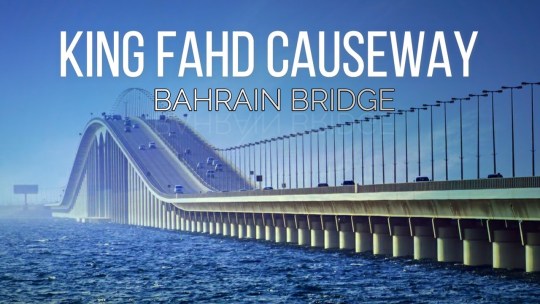
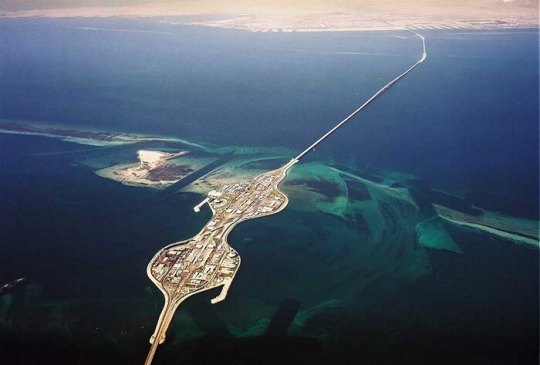
The 25 km King Fahd causeway that links Saudi Arabia to Bahrain.

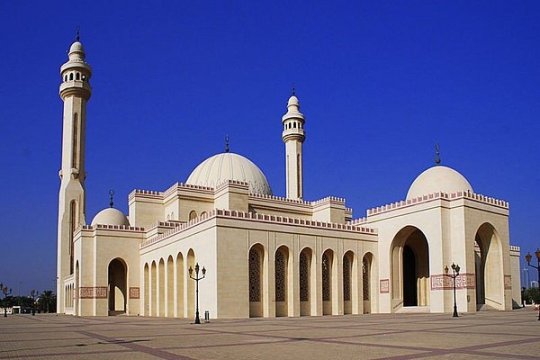

Manama, the modern capital of Bahrain.
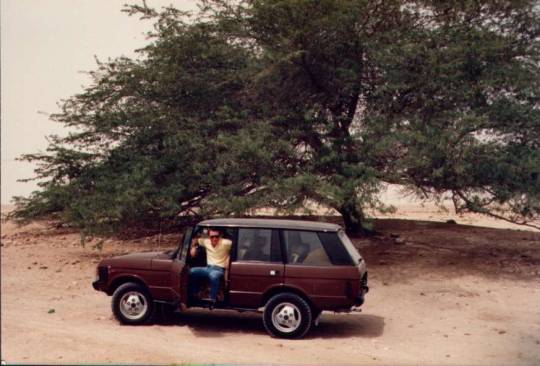
Bahrain desert - the Tree of Life


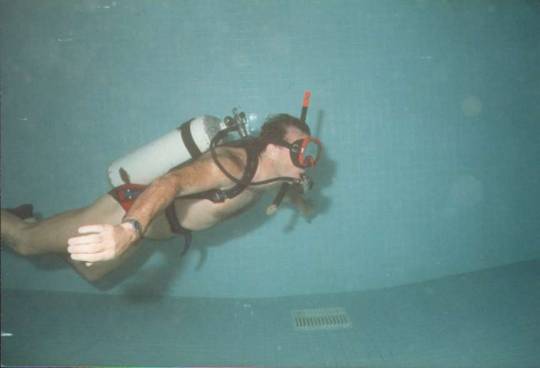
Bahrain life
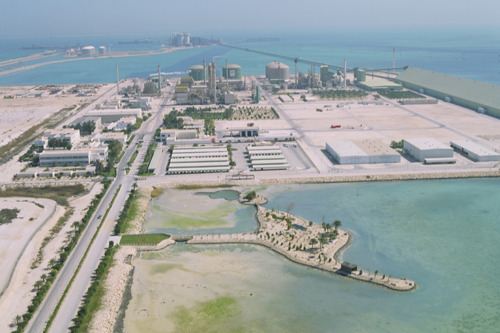
GPIC - Gulf Petrochemical Complex - Sitra Island, Bahrain
The winter between December 1984 and January 1985 was particularly harsh in Italy, characterized by increasingly lower temperatures. Between 13 and 17 January 1985, a depression centered on the Corsican Sea caused what is still remembered in Milan today as the snowfall of the century or the snowfall of '85, constituting the heaviest snowfall recorded in Milan in the 20th century. The snowfall caused serious damage. After four days of real storm, January 17th 1985 the Sports Hall collapsed in Milan due to the excessive weight of the snow that had accumulated on the roof.
In this certainly not festive atmosphere, I received a call from an engineering company in Milan, INTECH, an already a supplier of services to SNAMPROGETTI, with whom I soon agreed to leave for Bahrain.
From the SNAMPROGETTI office in San Donato, the Head of HR office Mr. Cincotta reassured me:
''It's a temporary destination, just a few months, waiting that construction of new Agadir International Airport will start … don't worry…''
I stayed there for 4 years…….
Mind you, not that I minded: Bahrain was a liveable place (drinkable, in the language of shipbuilders) especially because it also allowed families to reach the employees involved in the project.
I then left at the beginning of March 1984, with a flight via Kuwait.
I arrived at Manama airport and believe it or not there was someone waiting for me! A local guy holding a board with my name written on it almost correctly: Brino Sirino….
Bahrain is a small Emirate in the Persian Gulf (Kaleejj el Arabi) made up of a main island and a myriad of uninhabited islets. It is the ''poorest'' Gulf state, relative to its surrounding neighbors. Above all, Saudi Arabia provides the Emirate with considerable economic aid as the ruling house of Bahrain, like the Al Saud, is of the Sunni faith, in spite to a majority Shiite population
The Saudis would never allow a Shiite regime to be established 25 km from the Saudi coast with the approval of the ''Great Enemy'' Iran. And then Bahrain was a sort of ''playground'' for Saudis looking for entertainment just outside their front door. This therefore explains the reason for the economic support to Bahrain by the Saudis. For instance, one of the largest oil well in Saudi waters has always been exploited for free by the Bahraini oil industry. The construction of the 23 km long bridge that connects Saudi Arabia to the island of Bahrain was financed by the Saudis. The free sale of alcohol in Manama by shops managed by a company belonging to the ruling Bahraini family is another concession aimed at helping the Emir Al Khalifa's coffers. In 1986, shortly before the opening of the Dahran – Manama bridge to traffic, King Fahad proposed to the Emir Sheik Eissa the prohibition of alcohol sale, promising to compensate the Emir for the lost earnings: an offer returned to the sender.
On top of all this, about 50% of the Southern territory of the island of Bahrain is off limits, due to the largest naval base leased to the US in the Gulf. However, Manama has since then been a modern city, full of skyscrapers, luxury hotels and shopping centres.
AWALI
I was housed in Awali, a village of wooden houses built by the Americans of Caltex in 1939, when the first refinery in Bahrain (and the entire Persian Gulf) was built. Someone later told me that around 1942 some Italian planes departing from a base in Egypt tried to bomb the refinery, which produced fuel for the English army. Not having enough fuel to guarantee the return, the planes dropped their bombs into the sea just before the island of Bahrain, and aborted the mission.
The village of Awali is located almost in the center of the main island of Bahrain, and its wooden houses are reminiscent of those from the Lassie TV series in every way, including anti-mosquito doors. The houses are 2 and 4 bedrooms, with a large living-dining room, kitchen and two bathrooms. I was assigned to a small 4 bedroom house, but when I got there I was the only occupant. The village also had a club with a partially covered swimming pool (to prevent the summer sun from making the water too hot) and tennis courts, to which we had free access.
RONCI ATHOS
A few days after my arrival, around 3.00 AM, I heard some noises: the sound of a car stopping, doors slamming, and than someone throwing something (I than saw that it was suitcases…) inside the house. , on the wooden floor. Then the door of my room suddenly open, and someone said:
Are you asleep?
Before you arrived I was asleep…….
However...... - says the guy - I'm not going to stay here…….tomorrow I'll talk to the HR and then I'll see .....
Okay…. I say…. do as you like but let me sleep now….
For the record, Mr. Ronci Athos – Umbrian from Narni – was still there in 1993, in the place that 8 years earlier he had said he would leave as soon as possible….
THE PROJECT
Our client was called GPIC - Gulf Petrochemical Industries Company - a mixed Bahraini, Saudi and Kuwaiti capital company - and was part of the economic aid package from the rich Gulf countries to the ''poor'' relative of Bahrain.
Later, at the time of the commissioning and start up of the plants - we would have transformed the acronym into Gruppo Pensionati Italiani Comerint, given the average age of the people that the then company 'ENI had sent to proceed with the commissioning of the plants.
The project was in its final phase, and was directed by none other than the P.I. Manoli Benito Italo. Bahrain would be his last construction site personally managing, before becoming Director of the CSO Service of SNAMPROGETTI. The works were even ahead of schedule, so SNAMPROGETTI enjoyed a lot of credit with the Client. Upon delivery of the plant, the Client gifted an extra bonus of 4 million dollars to SNAMPROGETTI for its performance.
The credit was than canceled in 1990, during the first Gulf War. GPIC invited SNAMPROGETTI, BECHTEL and UHUDE to provide an initial feasibility study for a urea plant to be built alongside the existing ammonia and methanol plants. BECHTEL replied that she was not interested, SNAMPROGETTI sent a fax requesting an advance of 11,000 USD for the preliminary study. The Germans from HUDE, sensing the deal, in the midst of the Gulf War, sent a representative to Bahrain to discuss the possibility of building the urea plant. In 1992 the belated SANMPROGETTI envoy to Manama was detained at the entrance gate of the plant for a couple of hours, only to be informed that GPIC had officially commissioned UHUDE with the preliminary study.
COMMISSIONING & START UP
The long phase of pre-commissioning, commissioning and start-up of the plants soon began. Which were built on a so-called reclaimed land (an artificial island) created by dredging the shallow seabed, characteristic of the Bahraini island. The artificial island - equipped for safety reasons with an outer gate and an inner gate - was connected to the mainland by a causeaway approximately 3 kilometers long, and a second causeaway joined the island to the loading arms of the products, 10 kilometers further into the sea. This is to allow ships to carry out loading operations in complete safety, without the risk of running aground in the shallow seabed. There were many wrecks of ships stranded along the channel dug by the open sea up to the port of Manama - this much to the happiness of the divers, given that the wrecks had been transformed into sanctuaries of Persian Gulf tropical fish.
However, I must say a word to describe the characters who are part of the commissioning – start up. These particular people, who believe they are a sort of ''NASA scientists'' intent on launching the SPACE SHUTTLE into space. As soon as they arrived at site their aim was: ''Okay, get rid of Construction people, we're here now''.
The fact is that, apart from 3 or 4 of them who really knew what they were doing and were experts in the difficult process of putting the plants into operation (very dangerous indeed) all the others followed suit: ''they claimed to know'' and the less they knew, the more they pretended they were knewing. I met someone who, as soon as they heard someone approaching, started to talk about chemical formulas, operating pressures, and so on, just to put on airs.
In any case, within 3 months the start up team had managed to get the two plants up and running, even if the (rhetorical) question that was circulating was - Did you make the methanol?'' ''no…I didn't…So who did it?? No one knows.... ''
Tawfeeq Mohammed Rasul Almansoor - GPIC President
The President of GPIC, however, did not seem entirely satisfied, and he demonstrated it with a series of actions that were surprising to say the least.
One day Mr. Tawfiq arrived at high speed at the outer gate driving his metallic blue Rolls Royce. The presence of smat guy on the guard post prevented him from ending up against the bars at the outer check point.
Mr Tawfiq continued on the causeway at full speed and the inner gate guard, warned by radio by his colleague at the outer gate, promptly raised the bars. The President's Rolls entered the area of the Administrative offices, where he finally stopped. Tawfiq got out of the car in a rage, and ordered the Security Chief who met him to organize a meeting within 15 minutes. Participants in addition to him were the Security Chef, the Director of COMERINT and the Security Advisor.
We mortals later learned that the Security Chef – an British guy, former officer in Hes Majesty's army, had been fired on the spot – Reason given by Mr. Tawifiq:
''Two gates were opened for me and I was able to drive my car into the plant – and this was because at the sight of my Rolls Royce the guards thought I was driving the car. What if he was a terrorist? What if I suddenly went crazy and wanted to attack the plant? What if I had been kidnapped by terrorists who were hiding in the car filled with explosives??'' (I remember that the Rolls Royce was equipped with tinted mirror windows which did not allow anyone to see who was driving the car.)
A few days later, a second episode, again with Mr. Tawifiq as absolute protagonist. He had gone between the Main Control Room and Plant Laboratory, in a fairly hidden corner of the plant, and had broken the glass of one of the fire alarms that send a signal to the Fire Department control room. He than set off the stopwatch on his Rolex Platinum Diamond Pearlmaster to see how long it would take for the firefighters to arrive. After 11 interminable minutes - I would like to point out that the Fire Station was about 700 meters from the place where Mr. Tawfiq was stationed - the firefighters arrived to find that it was a false alarm. Again an urgent meeting was called, where this time the HSE manager lost his job. The reason for such a delay – which according to Tawfiq could have led to a disaster in the event of a real fire – was that on the synoptic panel of the fire brigade control room it was not possible to identify precisely where the alarm had went off.
Just a week after the episode of the false fire, the start-up of the plants had been successfuly done. The plant was even proding more ammonia and methanol than expected, around 1,200 tons per day per product, instead of the 1,000 tons expected. But many of the ''COMERINT Pensioners'' who had participated in the commissioning were still circulating in the plant. As they say in Southern Italy, ''they were mugging''.
Obviously COMERINT was looking for all the plausible excuses to keep them in service, given the daily rates with which they were invoiced to the Customer. (an average of $1,200/day per person). The situation between COMERINT and GPIC had become very tense, with daily requests from the latter to demobilize the technicians.
One day Tawfiq lost patience, and went to the Main Control Room - still dressed in the traditional white disdasha, ghutra on his head, he surprised a swarm of Italians having coffee, talking about football, playing on the computer. Tawfiq, who had been taken like an ordinary local, turned to the bystanders waving his arms in the Arab manner and said:
''What is this? Coffee shop''?
The shift manager, at that moment sitting on the desk with a cup of coffee in his hand and his legs dangling, stood up and in a benevolent manner, took Tawfiq by the arm (a very serious mistake as per Arab habits) pointed to a door at the end of the corridor and told him :
Shouff (look) coffee shop for Arab is there, at the end of corridor – accompanying it all with a laugh.
Tawifiq, according to bystanders, didn't show any sign of upset - he left the Control Room, called the Italian Director on the phone. Mr Fiorentino, COMERINT top manager. Mr Tawfiq ordered that all those present at the unfortunate episode were boarded on the first plane to Italy. The offices in the North wing of the Control Room were closed until further notice.
But where the President of GPIC gave his best was at the final meeting with Construction Director Benito Italo Manoli and the entire SAMPROGETTI staff present. During the meeting, numbers of questions were raised which mainly concerned the safety of the systems. At a certain point Mr. Tawfiq turned directly to the Italian Doctor Mr. Busonero asking :
Doctor, in case of explosion of one or more tanks of ammonia or methanol, either due to a terrorist attack, or due to an accident, what could be the consequences?
Dead silence in the meeting room… gazes of all those present frantically crossing each other… Mr. Manoli trying to communicate via brain waves with Doct. Busonero, while coughs and noises of chairs moving rang out in the room…. ..and finally the Doctor, red in the face and with drops of sweat running down his forehead (despite the air conditioning being set to 19 degrees C – Tawfiq's favorite temperature) Doct. Busonero replied:
- Well…Mr. Tawifiq…with a prevailing wind from the South-East to the North-West, the inhabitants of Manama would have from 7 to 10 minutes to recommend each one's soul to God…''
It was freezing in the meeting room, no one said a word, everyone was waiting for the President's counter-reply. Tawfiq stood up and nodded to Mr. Manoli who followed him into President's private office.
The next day there was no trace of Doct. Busonero. We learned that he had been put on a plane to Rome before midnight, the deadline that Tawfiq had indicated to Mr. Manoli. Contrary, Doct. Busonero would have been arrested for telling the truth.
5 notes
·
View notes